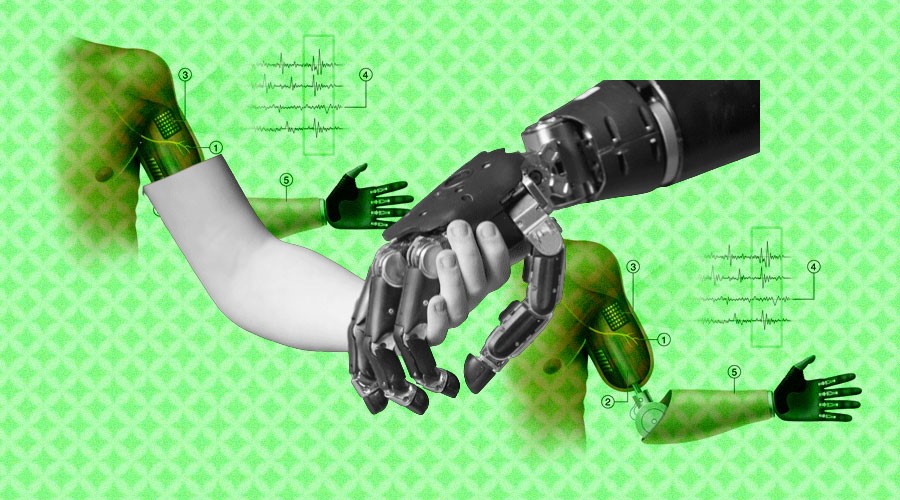
Ultrasound Stickers That Can See Inside the Body
New stamp-sized ultrasound adhesives deliver clear images of the heart, lungs, and other internal organs.
AbstractContinuous imaging of internal organs over days could provide crucial information about health and diseases and enable insights into developmental biology. We report a bioadhesive ultrasound (BAUS) device that consists of a thin and rigid ultrasound probe robustly adhered to the skin via a couplant made of a soft, tough, antidehydrating, and bioadhesive hydrogel-elastomer hybrid. The BAUS device provides 48 hours of continuous imaging of diverse internal organs, including blood vessels, muscle, heart, gastrointestinal tract, diaphragm, and lung. The BAUS device could enable diagnostic and monitoring tools for various diseases.
When clinicians need live images of a patient’s internal organs, they often turn to ultrasound imaging for a safe and noninvasive window into the body’s workings. In order to capture these insightful images, trained technicians manipulate ultrasound wands and probes to direct sound waves into the body. These waves reflect back out and are used to produce high-resolution images of a patient’s heart, lungs, and other deep organs.
Ultrasound imaging currently requires bulky and specialized equipment available only in hospitals and doctor’s offices. However, a new design developed by MIT engineers might make the technology as wearable and accessible as buying Band-Aids at the drugstore.
The engineers presented the design for the new ultrasound sticker in a paper published on July 28 in the journal Science. The stamp-sized device sticks to skin and can provide continuous ultrasound imaging of internal organs for 48 hours.
To demonstrate the invention, the researchers applied the stickers to volunteers. They showed the devices produced live, high-resolution images of major blood vessels and deeper organs such as the heart, lungs, and stomach. As the volunteers performed various activities, including sitting, standing, jogging, and biking, the stickers maintained a strong adhesion and continued to capture changes in underlying organs.
In the current design, the stickers must be connected to instruments that translate the reflected sound waves into images. According to the researchers, the stickers could have immediate applications even in their current form. For example, the devices could be applied to patients in the hospital, similar to heart-monitoring EKG stickers, and could continuously image internal organs without requiring a technician to hold a probe in place for long periods of time.
Making the devices work wirelessly is a goal the team is currently working toward. If they are successful, the ultrasound stickers could be made into wearable imaging products that patients could take home from a doctor’s office or even buy at a pharmacy.
“We envision a few patches adhered to different locations on the body, and the patches would communicate with your cellphone, where AI algorithms would analyze the images on demand,” says the study’s senior author, Xuanhe Zhao, professor of mechanical engineering and civil and environmental engineering at MIT. “We believe we’ve opened a new era of wearable imaging: With a few patches on your body, you could see your internal organs.”
The study also includes lead authors Chonghe Wang and Xiaoyu Chen, and co-authors Liu Wang, Mitsutoshi Makihata, and Tao Zhao at MIT, along with Hsiao-Chuan Liu of the Mayo Clinic in Rochester, Minnesota.
A sticky issueTo image with ultrasound, a technician first applies a liquid gel to a patient’s skin, which acts to transmit ultrasound waves. A probe, or transducer, is then pressed against the gel, sending sound waves into the body that echo off internal structures and back to the probe, where the echoed signals are translated into visual images.
For patients who require long periods of imaging, some hospitals offer probes affixed to robotic arms that can hold a transducer in place without tiring, but the liquid ultrasound gel flows away and dries out over time, interrupting long-term imaging.
In recent years, scientists have explored designs for stretchable ultrasound probes that would provide portable, low-profile imaging of internal organs. These designs gave a flexible array of tiny ultrasound transducers, the idea being that such a device would stretch and conform to a patient’s body.
But these experimental designs have produced low-resolution images, in part due to their stretch: In moving with the body, transducers shift location relative to each other, distorting the resulting image.
“Wearable ultrasound imaging tool would have huge potential in the future of clinical diagnosis. However, the resolution and imaging duration of existing ultrasound patches is relatively low, and they cannot image deep organs,” says Chonghe Wang, who is an MIT graduate student.
An inside lookBy pairing a stretchy adhesive layer with a rigid array of transducers, the MIT team’s new ultrasound sticker produces higher resolution images over a longer duration. “This combination enables the device to conform to the skin while maintaining the relative location of transducers to generate clearer and more precise images.” Wang says.
The device’s adhesive layer is made from two thin layers of elastomer that encapsulate a middle layer of solid hydrogel, a mostly water-based material that easily transmits sound waves. Unlike traditional ultrasound gels, the MIT team’s hydrogel is elastic and stretchy.
“The elastomer prevents dehydration of hydrogel,” says Chen, an MIT postdoc. “Only when hydrogel is highly hydrated can acoustic waves penetrate effectively and give high-resolution imaging of internal organs.”
The bottom elastomer layer is designed to stick to skin, while the top layer adheres to a rigid array of transducers that the team also designed and fabricated. The entire ultrasound sticker measures about 2 square centimeters across, and 3 millimeters thick — about the area of a postage stamp.
The researchers ran the ultrasound sticker through a battery of tests with healthy volunteers, who wore the stickers on various parts of their bodies, including the neck, chest, abdomen, and arms. The stickers stayed attached to their skin, and produced clear images of underlying structures for up to 48 hours. During this time, volunteers performed a variety of activities in the lab, from sitting and standing, to jogging, biking, and lifting weights.
From the stickers’ images, the team was able to observe the changing diameter of major blood vessels when seated versus standing. The stickers also captured details of deeper organs, such as how the heart changes shape as it exerts during exercise. The researchers were also able to watch the stomach distend, then shrink back as volunteers drank then later passed juice out of their system. And as some volunteers lifted weights, the team could detect bright patterns in underlying muscles, signaling temporary microdamage.
“With imaging, we might be able to capture the moment in a workout before overuse, and stop before muscles become sore,” says Chen. “We do not know when that moment might be yet, but now we can provide imaging data that experts can interpret.”
The engineering team is working to make the stickers function wirelessly. They are also developing software algorithms based on artificial intelligence that can better interpret and diagnose the stickers’ images. Then, Zhao envisions ultrasound stickers could be packaged and purchased by patients and consumers, and used not only to monitor various internal organs, but also the progression of tumors, as well as the development of fetuses in the womb.
“We imagine we could have a box of stickers, each designed to image a different location of the body,” Zhao says. “We believe this represents a breakthrough in wearable devices and medical imaging.”
Reference: “Bioadhesive ultrasound for long-term continuous imaging of diverse organs” by Chonghe Wang, Xiaoyu Chen, Liu Wang, Mitsutoshi Makihata, Hsiao-Chuan Liu, Tao Zhou and Xuanhe Zhao, 28 July 2022, Science. DOI: 10.1126/science.abo2542 This research was funded, in part, by MIT, the Defense Advanced Research Projects Agency, the National Science Foundation, the National Institutes of Health, and the U.S. Army Research Office through the Institute for Soldier Nanotechnologies at MIT.






















